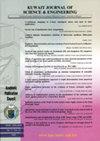Determination of antimicrobial resistance profiles and molecular detection of carbapenemases in Gram negative bacilli isolated from different sources in Mosul city, Iraq
引用次数: 0
Abstract
The objectives of the present study were to determine the antimicrobial resistance profiles and evaluate the occurrence of metallo-β-lactamase and other carbapenemases in Gram-negative bacilli isolated from different sources in Mosul city. Bacterial isolates were recovered from clinical, veterinary, and environmental specimens and samples. Pure isolates were identified and tested for determination of their antimicrobial resistance profiles using disk diffusion method. Phenotypic detection of metallo-carbapenemase-producing bacteria was conducted using combined disk method. Imipenem-resistant strains were subjected to molecular detection of carbapenemase genes ( bla VIM , bla KPC , bla NDM , bla OXA-48 , bla IMP ) using multiplex PCR. Three hundred and ninety three bacterial isolates were recovered from (365) specimens and samples, 246 isolates (62.6%) were multi-drug resistant (MDR). The isolates were highly resistant to amoxicillin-clavulanic acid, tetracycline, cefotaxime, sulfamethoxazole, and ceftriaxone (96.7%, 65.1%, 64.1% and 63.6%, and 63.1% respectively). Carbapenems were the most effective antimicrobials used, the percentages of isolates resistant to imipenem and meropenem were (12.5%), and (10.7%), respectively. The study found that (7.4%) of the isolates were metallo-carbapenemase producers, phenotypically. Multiplex PCR results revealed that 47/49 (95.5%) imipenem-resistant isolates were positive for PCR detection test, isolates with double genes ( bla KPC + bla VIM and bla KPC + bla NDM ) were the most prevalent (n=9; 18.4% for each), followed by bla KPC and bla NDM (n=8; 16.3% for each), and bla VIM (n=6; 12.2% ). Three isolates (6.1%) were positive for bla IMP and two others (4.1%) were positive for each of bla OXA-48 and bla KPC + bla OXA-48 , while two isolates (4.1%) gave a negative result for the test. In conclusion, carbapenemase genes were detected in the environmental isolates as well as in the clinical and veterinary ones, which might suggest the transmission of carbapenemase-producing bacteria and /or resistance determinants from clinical and veterinary settings to the environment.伊拉克摩苏尔市不同来源革兰氏阴性杆菌耐药谱测定及碳青霉烯酶分子检测
本研究的目的是确定摩苏尔市不同来源分离的革兰氏阴性杆菌的抗微生物药物耐药性特征,并评估金属β-内酰胺酶和其他碳青霉烯酶的发生情况。从临床、兽医和环境标本和样品中分离出细菌。采用纸片扩散法对纯分离菌进行鉴定和耐药谱测定。采用联合圆盘法对金属碳青霉烯酶产菌进行表型检测。采用多重PCR方法检测耐亚胺培南菌株的碳青霉烯酶基因(bla VIM、bla KPC、bla NDM、bla OXA-48、bla IMP)。共检出393株细菌,其中246株(62.6%)为多药耐药(MDR)。对阿莫西林-克拉维酸、四环素、头孢噻肟、磺胺甲恶唑和头孢曲松的耐药率分别为96.7%、65.1%、64.1%、63.6%和63.1%。碳青霉烯类药物是最有效的抗菌药物,对亚胺培南和美罗培南的耐药比例分别为12.5%和10.7%。研究发现(7.4%)的分离株在表型上是金属碳青霉烯酶的生产者。多重PCR结果显示,47/49株(95.5%)亚胺培南耐药菌株PCR检测阳性,以双基因(bla KPC + bla VIM和bla KPC + bla NDM)菌株最多(n=9;各占18.4%),其次是bla KPC和bla NDM (n=8;各占16.3%),bla VIM (n=6;12.2%)。bla IMP阳性3株(6.1%),bla OXA-48和bla KPC + bla OXA-48各阳性2株(4.1%),阴性2株(4.1%)。总之,在环境分离株以及临床和兽医分离株中检测到碳青霉烯酶基因,这可能表明碳青霉烯酶产生菌和/或耐药决定因素从临床和兽医环境传播到环境。
本文章由计算机程序翻译,如有差异,请以英文原文为准。
求助全文
约1分钟内获得全文
求助全文
来源期刊

Kuwait Journal of Science & Engineering
MULTIDISCIPLINARY SCIENCES-
自引率
0.00%
发文量
0
审稿时长
3 months
 求助内容:
求助内容: 应助结果提醒方式:
应助结果提醒方式:


